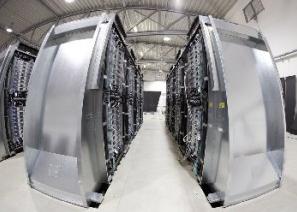
HP and Intel have teamed up to design and build a new supercomputing system for the US Department of Energy’s National Renewable Energy Laboratory (NREL), which promises to be one of the most efficient installations in the world.
The new system will be powered by a combination of current 32nm Xeon E5 processors and future 22nm Ivy Bridge processors, together with around 600 Xeon Phi co-processors (based on Intel’s MIC architecture), running inside HP ProLiant Gen 8 servers.
The total peak performance of the system is expected to exceed 1 Petaflop (equivalent to a thousand trillion floating point operations per second), and it will be the largest supercomputer dedicated solely to renewable energy and energy efficiency research.
The installation will not use traditional mechanical or compressor-based cooling systems, but instead will use warm water liquid cooling technology to maximise the reuse of heat.
Excess heat from the computer system will be pumped into the adjacent office and lab space and exported to other areas of the NREL campus, to cut down on central heating costs.
This cooling system, together with innovative data centre design, is expected to result in the NREL facility becoming the world’s most efficient data centre, with a power usage effectiveness (PUE) rating of 1.06 or better.
“At NREL, we have taken a holistic approach to sustainable computing,” said Steve Hammond, NREL Computational Science director. “This new system will allow NREL to increase our computational capabilities while being mindful of energy and water used.”
Intel claims that the inclusion Intel Xeon Phi co-processors is key to making the facility energy and performance efficient. NREL participated in the software development for Intel’s MIC architecture, and found that it took only a few days to port half a million lines of code using Intel Xeon Phi cores.
“Modelling the wind energy system from meteorological to turbine scales means squeezing every last ounce of performance from our simulations,” said NREL scientist John Michalakes.
“The ability to develop and optimise using the same software ecosystem as the host Intel Xeon processor is a tremendous boost for application performance, scaling and programmer productivity.”
The NREL system is scheduled for completion in the summer of 2013.
The power consumption of supercomputers is one of the major issues facing the industry, because as clusters get bigger and more powerful, there is often not enough energy to keep them running.
At the International Supercomputing Conference in Hamburg earlier this year, it emerged that some of the most powerful supercomputers in the world are also the most power efficient.
The average power consumption of a TOP10 system was found to be 4.09 MW (down from 4.56MW six months earlier). By comparison, the average power consumption of a TOP500 system was 671.3kW (up from 634kW six months earlier).
“Supercomputing is very much a market where innovation comes from the top and trickles down,” said Erich Strohmaier, head of the Future Technology Group at the Lawrence Berkeley National Laboratory (LBNL).
“The new stuff, as soon as we have confidence that it works, it’s going to get introduced in a very large system. That’s why the large systems have higher efficiency than the small systems,” he added.





